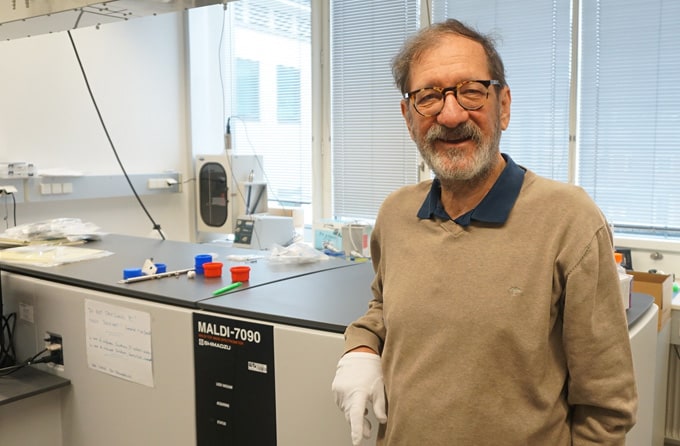Celebrating 50 Years of MS Innovation - User interviews July 2020
On the occasion of Shimadzu's 50th year of producing mass spectrometry instruments, we talk to researchers using Shimadzu MS instruments in their daily work and ask about their expectations for Shimadzu and the future of MS technology.

Guenter Allmaier PhD., Full professor of Analytical Chemistry
Institute of Chemical Technologies and Analytics, Vienna University of Technology (TU Wien), Vienna, Austria
Main field of study:
Analytical chemistry including instrumentation with a focus on bio and polymer analysis
1. How did you become familiar with Shimadzu?
Well, after my post doc in the labs of Prof. K. Biemann and G. Khorana (both MIT, Cambridge, MA, USA) and learning for the first time to handle a Japan-built 4-sector mass spectrometer, I started as a young assistant professor at the Institute of Analytical Chemistry (University of Vienna, Austria) and was thinking about my future research. During my master thesis I came into contact with a home-build LDI source attached to a Kratos MS50 magnetic sector field device (F. Heresch et al., Anal. Chem. 52, 1803 (1980).). Due to this fact and my ideas for the future I was considering moving into the emerging field of LDI time-of-flight mass spectrometry of biomolecules as a future research topic (MALDI had not yet been introduced). In the late 80s Shimadzu offered an interestingly designed LDI reflectron mass spectrometer termed LAMS-50K and I contacted the local Austrian Shimadzu dealer, but he had to tell me that unfortunately this device was not available for sale in Europe.
2. What is your main field of research, and how are you utilizing Shimadzu equipment?
My main field of research is mass spectrometry with a focus on MALDI and ESI, ES differential mobility analysis and capillary/2-dimensional planar electrophoresis applied to biomolecules, technical polymers and nanoparticles as liposomes or intact viruses. For my proteomic and lipidomic studies as well as imaging MS we apply the CHIP-1000 chemical ink jet printer for different methods of MALDI MS sample preparation. Further down the road of investigation, during the last two years we used the Shimadzu Kratos Analytical MS 7090 as well as AximaToF2 for structural analysis in the high-energy CID MS/MS mode and Axima CFR+ with an attached CovalX high mass detector for protein molecular mass determination. Additionally, we use the Nexera LCMS-8060 in our amino acid analysis as well as metabolomic/bioprocess studies.
3. What are your reasons for choosing Shimadzu equipment?
My small lab at the University of Vienna started out in the early 90s with the desk-top instrument Kompact MALDI IV and moved on to the Axima CFR device, which turned out to be a real reliable scientific workhorse for many years in my group. This observation and furthermore the excellent collaboration with Shimadzu Kratos Analytical in Manchester and the tremendous support by the local Austrian Shimadzu representatives, as well as Shimadzu Europe in Duisburg, makes me think all the time about possible Shimadzu analytical instrumentation, as for example moving from the University of Vienna to the Vienna University of Technology (TU Wien). The robustness as well as long-term stability of mass spectrometric as well as chromatographic equipment in combination with competitive prices makes it often the device-of-choice in a bioanalytical lab directed towards international competitive research and teaching at a world-class technical university (TU Wien).
4. What trends are you seeing in your field with regards to the use of mass spectrometry?
The trend is towards faster, higher resolution in standard mode and more reliable mass spectrometers. Miniaturizing is also a challenge together with more powerful data handling and interpretation. Imaging MS in its different variations is gaining more and more impact in the biomedical field as well as in material sciences. Furthermore, separation techniques (i.e. nano RP-HPLC or CZE) with mass spectrometry are gaining exponential growth and are mandatory in research and development in science.
5. What are your expectations for Shimadzu and for MS technology in general in the future?
In the area of desorption/ionization techniques, the most important facet responsible for the exponential growth of mass spectrometry, we see the constant search for new techniques which would allow us to generate more ions than existing techniques from decreasing amounts of compounds. Multistage MS fragmentation in different energy regimes by different means (gas molecules, UV photons, slow electrons, electron transfer reactions, etc.) which would allow us to collect more structural information with less material used within one device. Multistage MS with ultra-high resolution (enabling the determination of the elemental composition of all fragment ions as well as precursor ions).



